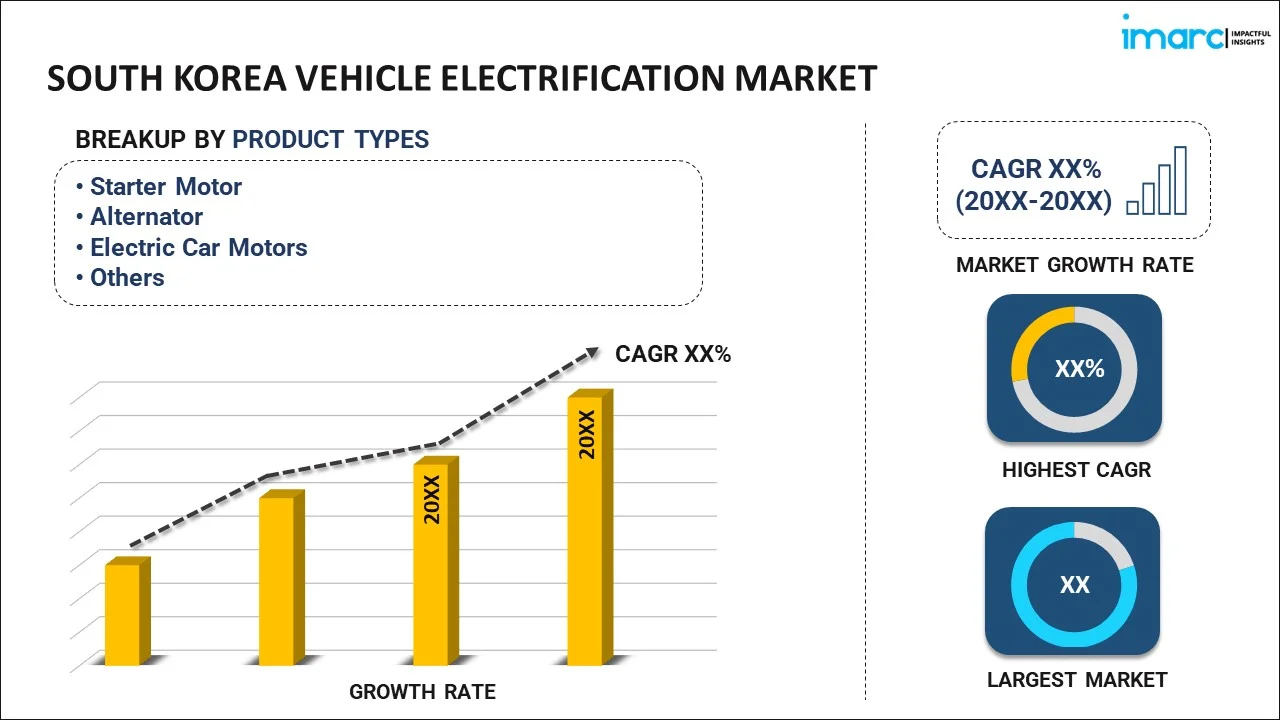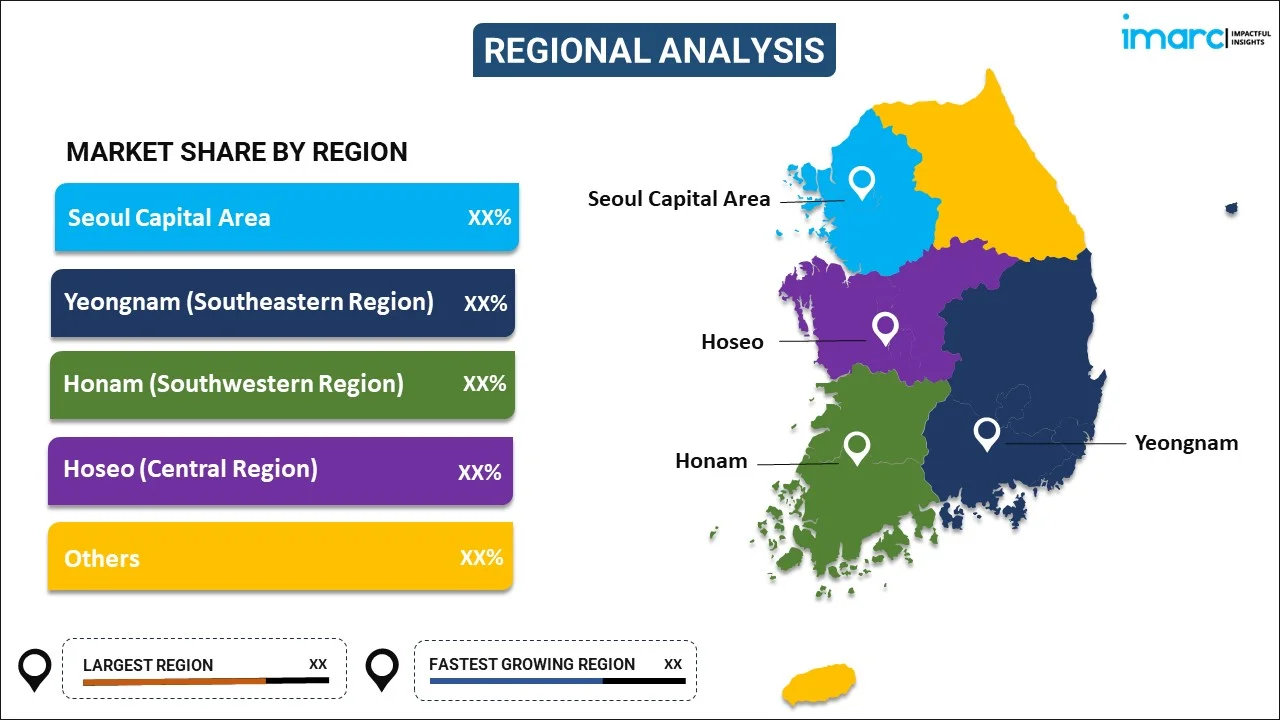
South Korea Vehicle Electrification Market Report by Product Type (Starter Motor, Alternator, Electric Car Motors, Electric Water Pump, Electric Oil Pump, Electric Vacuum Pump, Electric Fuel Pump, Electric Power Steering, Actuators, Start/Stop System), Vehicle Type (Internal Combustion Engine (ICE) and Micro-Hybrid Vehicle, Plug-in Hybrid Electric Vehicle (PHEV) and Battery Electric Vehicle (BEV), Hybrid Electric Vehicle (HEV)), Sales Channel (Original Equipment Manufacturers (OEM), Aftermarket), and Region 2024-2032
Market Overview:
South Korea vehicle electrification market size is projected to exhibit a growth rate (CAGR) of 11.80% during 2024-2032. The growing demand for cleaner transportation options, rising need to reduce greenhouse gas (GHG) emissions and meet stringent emission regulations, and increasing awareness about environmental issues represent some of the key factors driving the market.
|
Report Attribute
|
Key Statistics
|
|---|---|
|
Base Year
|
2023 |
|
Forecast Years
|
2024-2032
|
|
Historical Years
|
2018-2023
|
| Market Growth Rate (2024-2032) | 11.80% |
Vehicle electrification is the transition from traditional internal combustion engine (ICE) vehicles to electric-powered vehicles. It involves the integration of electric technology in various forms, such as hybrid electric vehicles (HEVs), plug-in hybrid electric vehicles (PHEVs), battery-electric vehicles (BEVs), and fuel-cell electric vehicles (FCEVs). It can make vehicles more environment friendly and energy-efficient. It plays a pivotal role in reducing dependence on imported oil and enhancing energy security. It offers a smooth and quiet driving experience while providing instant torque. It reduces dependency on fossil fuels, mitigates environmental impacts, and enhances overall vehicle efficiency. It assists in reducing noise pollution and improving air quality while maintaining a cleaner and greener environment. Besides this, it aids in minimizing emissions of harmful pollutants, such as nitrogen oxides (NOx) and particulate matter (PM). As it benefits in improving fuel efficiency and reducing emissions compared to conventional gasoline-powered vehicles, the demand for vehicle electrification is increasing in South Korea.
South Korea Vehicle Electrification Market Trends:
At present, the rising adoption of vehicle electrification to address environmental concerns, reduce greenhouse gas (GHG) emissions, and meet stringent emission regulations represents one of the primary factors contributing to the growth of the market in South Korea. In line with this, the growing demand for EVs, as they have fewer maintenance costs compared to ICE vehicles, is offering a positive market outlook. Moreover, the increasing development of high-capacity batteries assist in improving the range and performance of EVs is bolstering the market growth in the country. Apart from this, there is a rise in the need for cleaner transportation options among individuals. This, coupled with the increasing number of charging stations is supporting the market growth. Additionally, governing agencies in South Korea are encouraging the adoption of electric vehicles (EVs) to reduce environmental impact. They are also providing numerous incentives, such as tax credits, rebates, and reduced registration fees on purchase of EVs, which is strengthening the market growth. Besides this, the escalating demand for EVs, as they provide enhanced safety and comfortable driving experience to individuals, along with the rising awareness about environmental issues among the masses, is positively influencing the market in South Korea. Furthermore, the increasing use of clean energy sources for EV charging, such as solar or wind power, that benefits in enhancing the sustainability of EVs is offering lucrative growth opportunities to industry investors. In addition, the rising focus on vehicle electrification on account of inflating fuel prices is propelling the market growth in the country.
South Korea Vehicle Electrification Market Segmentation:
IMARC Group provides an analysis of the key trends in each segment of the market, along with forecasts at the country level for 2024-2032. Our report has categorized the market based on product type, vehicle type, and sales channel.
Product Type Insights:

- Starter Motor
- Alternator
- Electric Car Motors
- Electric Water Pump
- Electric Oil Pump
- Electric Vacuum Pump
- Electric Fuel Pump
- Electric Power Steering
- Actuators
- Start/Stop System
The report has provided a detailed breakup and analysis of the market based on the product type. This includes starter motor, alternator, electric car motors, electric water pump, electric oil pump, electric vacuum pump, electric fuel pump, electric power steering, actuators, and start/stop system.
Vehicle Type Insights:
- Internal Combustion Engine (ICE) and Micro-Hybrid Vehicle
- Plug-in Hybrid Electric Vehicle (PHEV) and Battery Electric Vehicle (BEV)
- Hybrid Electric Vehicle (HEV)
A detailed breakup and analysis of the market based on the vehicle type have also been provided in the report. This includes internal combustion engine (ICE) and micro-hybrid vehicle, plug-in hybrid electric vehicle (PHEV) and battery electric vehicle (BEV), and hybrid electric vehicle (HEV).
Sales Channel Insights:
- Original Equipment Manufacturers (OEM)
- Aftermarket
The report has provided a detailed breakup and analysis of the market based on the sales channel. This includes original equipment manufacturers (OEM) and aftermarket.
Regional Insights:

- Seoul Capital Area
- Yeongnam (Southeastern Region)
- Honam (Southwestern Region)
- Hoseo (Central Region)
- Others
The report has also provided a comprehensive analysis of all the major regional markets, which include Seoul Capital Area, Yeongnam (Southeastern Region), Honam (Southwestern Region), Hoseo (Central Region), and others.
Competitive Landscape:
The market research report has also provided a comprehensive analysis of the competitive landscape in the market. Competitive analysis such as market structure, key player positioning, top winning strategies, competitive dashboard, and company evaluation quadrant has been covered in the report. Also, detailed profiles of all major companies have been provided.
South Korea Vehicle Electrification Market Report Coverage:
| Report Features | Details |
|---|---|
| Base Year of the Analysis | 2023 |
| Historical Period | 2018-2023 |
| Forecast Period | 2024-2032 |
| Units | US$ Million |
| Scope of the Report | Exploration of Historical and Forecast Trends, Industry Catalysts and Challenges, Segment-Wise Historical and Predictive Market Assessment:
|
| Product Types Covered | Starter Motor, Alternator, Electric Car Motors, Electric Water Pump, Electric Oil Pump, Electric Vacuum Pump, Electric Fuel Pump, Electric Power Steering, Actuators, Start/Stop System |
| Vehicle Types Covered | Internal Combustion Engine (ICE) and Micro-Hybrid Vehicle, Plug-in Hybrid Electric Vehicle (PHEV) and Battery Electric Vehicle (BEV), Hybrid Electric Vehicle (HEV) |
| Sales Channels Covered | Original Equipment Manufacturers (OEM), Aftermarket |
| Regions Covered | Seoul Capital Area, Yeongnam (Southeastern Region), Honam (Southwestern Region), Hoseo (Central Region), Others |
| Customization Scope | 10% Free Customization |
| Report Price and Purchase Option | Single User License: US$ 3699 Five User License: US$ 4699 Corporate License: US$ 5699 |
| Post-Sale Analyst Support | 10-12 Weeks |
| Delivery Format | PDF and Excel through Email (We can also provide the editable version of the report in PPT/Word format on special request) |
Key Questions Answered in This Report:
- How has the South Korea vehicle electrification market performed so far and how will it perform in the coming years?
- What has been the impact of COVID-19 on the South Korea vehicle electrification market?
- What is the breakup of the South Korea vehicle electrification market on the basis of product type?
- What is the breakup of the South Korea vehicle electrification market on the basis of vehicle type?
- What is the breakup of the South Korea vehicle electrification market on the basis of sales channel?
- What are the various stages in the value chain of the South Korea vehicle electrification market?
- What are the key driving factors and challenges in the South Korea vehicle electrification?
- What is the structure of the South Korea vehicle electrification market and who are the key players?
- What is the degree of competition in the South Korea vehicle electrification market?
Key Benefits for Stakeholders:
- IMARC’s industry report offers a comprehensive quantitative analysis of various market segments, historical and current market trends, market forecasts, and dynamics of the South Korea vehicle electrification market from 2018-2032.
- The research report provides the latest information on the market drivers, challenges, and opportunities in the South Korea vehicle electrification market.
- Porter's five forces analysis assist stakeholders in assessing the impact of new entrants, competitive rivalry, supplier power, buyer power, and the threat of substitution. It helps stakeholders to analyze the level of competition within the South Korea vehicle electrification industry and its attractiveness.
- Competitive landscape allows stakeholders to understand their competitive environment and provides an insight into the current positions of Key Players in the market.
Need more help?
- Speak to our experienced analysts for insights on the current market scenarios.
- Include additional segments and countries to customize the report as per your requirement.
- Gain an unparalleled competitive advantage in your domain by understanding how to utilize the report and positively impacting your operations and revenue.
- For further assistance, please connect with our analysts.
 Inquire Before Buying
Inquire Before Buying
 Speak to an Analyst
Speak to an Analyst
 Request Brochure
Request Brochure
 Request Customization
Request Customization




.webp)




.webp)












